Golf is an outdoor sport in which a player attempts to hit a small, hard ball into a hole with as few swings as possible. Players hit the ball with one of several kinds of long, slender golf clubs. Golf is played on a course that normally is divided into 18 units, also called holes, of varying lengths and difficulty.
Golf is one of the most popular outdoor sports in the world. Millions of men, women, and children play golf as an individual or team sport, and in high school and college competition. Millions more enjoy golf as a form of recreation and exercise. Golf is also a popular spectator sport, attracting thousands of fans to tournaments. Millions more watch tournaments on television.
There are tens of thousands of golf courses throughout the world. The United States has thousands of them. Most are daily fee courses, which are facilities that admit the public for a fee. The majority of these courses are privately owned. The remainder are publicly owned. There are also a large number of private courses—country clubs and golf clubs available to members only. This article mainly discusses the sport of golf as it is played in the United States.
The course
Golf courses have no regulation length or shape, but most consist of 18 holes numbered 1 to 18. Playing all 18 holes makes up a round of golf. Some courses have only nine holes.

An 18-hole course averages about 140 acres (57 hectares). Each hole includes a tee, a fairway, a green, and often one or more hazards. At most courses, tee placements range from 5,000 to more than 7,000 yards (4,600 to 6,400 meters) in length, allowing players to play course lengths best suited for their level of play.
A golf course contains a mixture of par 3, par 4, and par 5 holes. A player shoots par by hitting the ball from the tee into the hole in a certain number of strokes, usually 3, 4, or 5. For men golfers, a typical par 3 hole measures up to 260 yards (240 meters), a par 4 from 241 to 490 yards (220 to 550 meters), and a par 5 at least 450 yards (410 meters)—and often more than 500 yards (460 meters). Yardages from forward tees are somewhat shorter.
Golf courses are usually laid out in a loop that brings the golfer back to a point near the first tee at the end of each nine holes. The holes are arranged so that players are relatively safe from balls hit by players on another hole. Golfers shout the traditional warning “Fore!” to alert other golfers that a ball has been hit in their direction.
The tee.
Each golf hole begins at the tee, a small flat area from which the golfer takes the first stroke, or shot. This stroke is called a drive. Before hitting the ball, the golfer places it on a wooden or plastic peg that is also called a tee. The peg may only be used on the tee. After the tee shot, the golfer must hit the ball as it lies on the course.
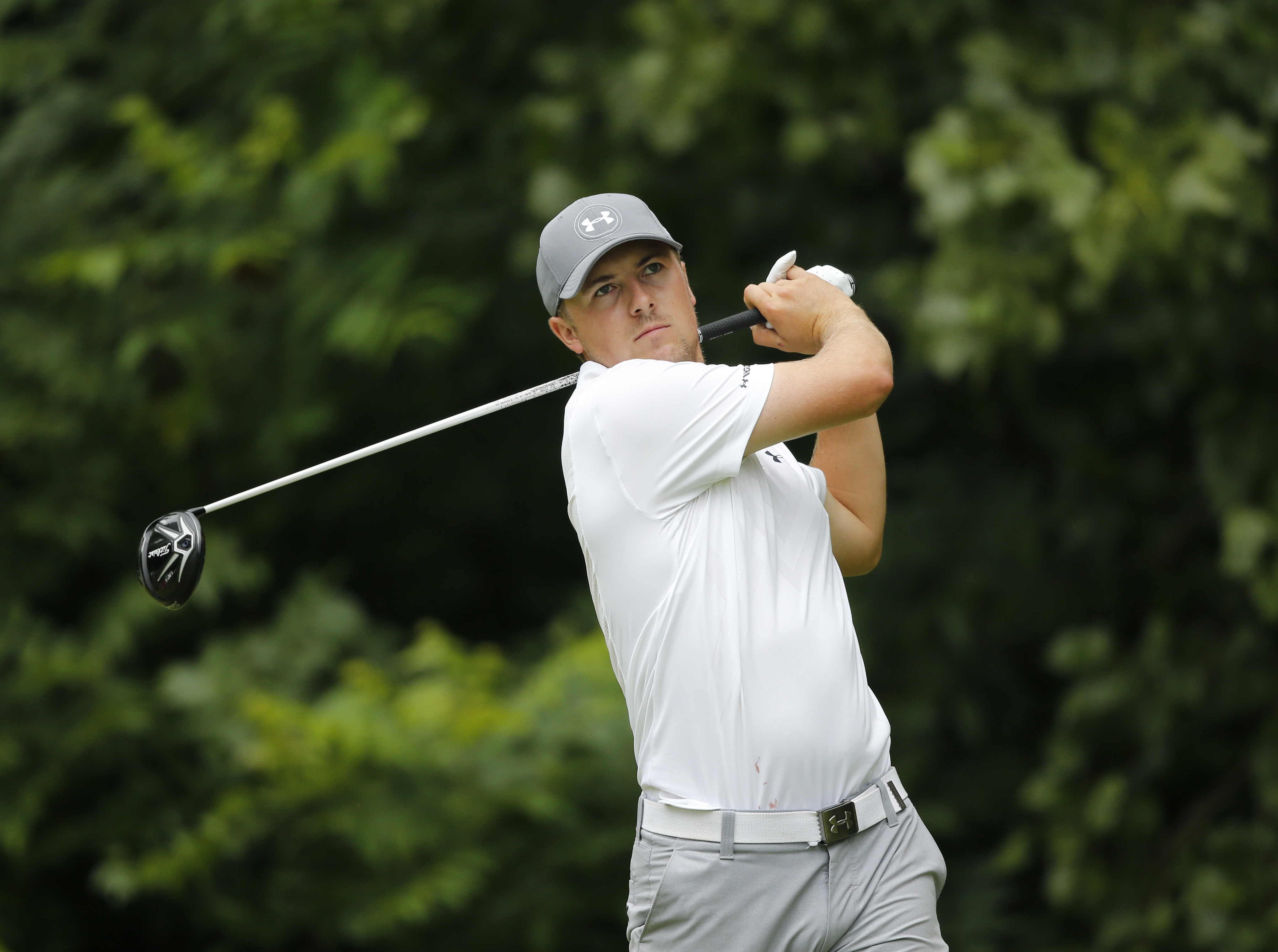
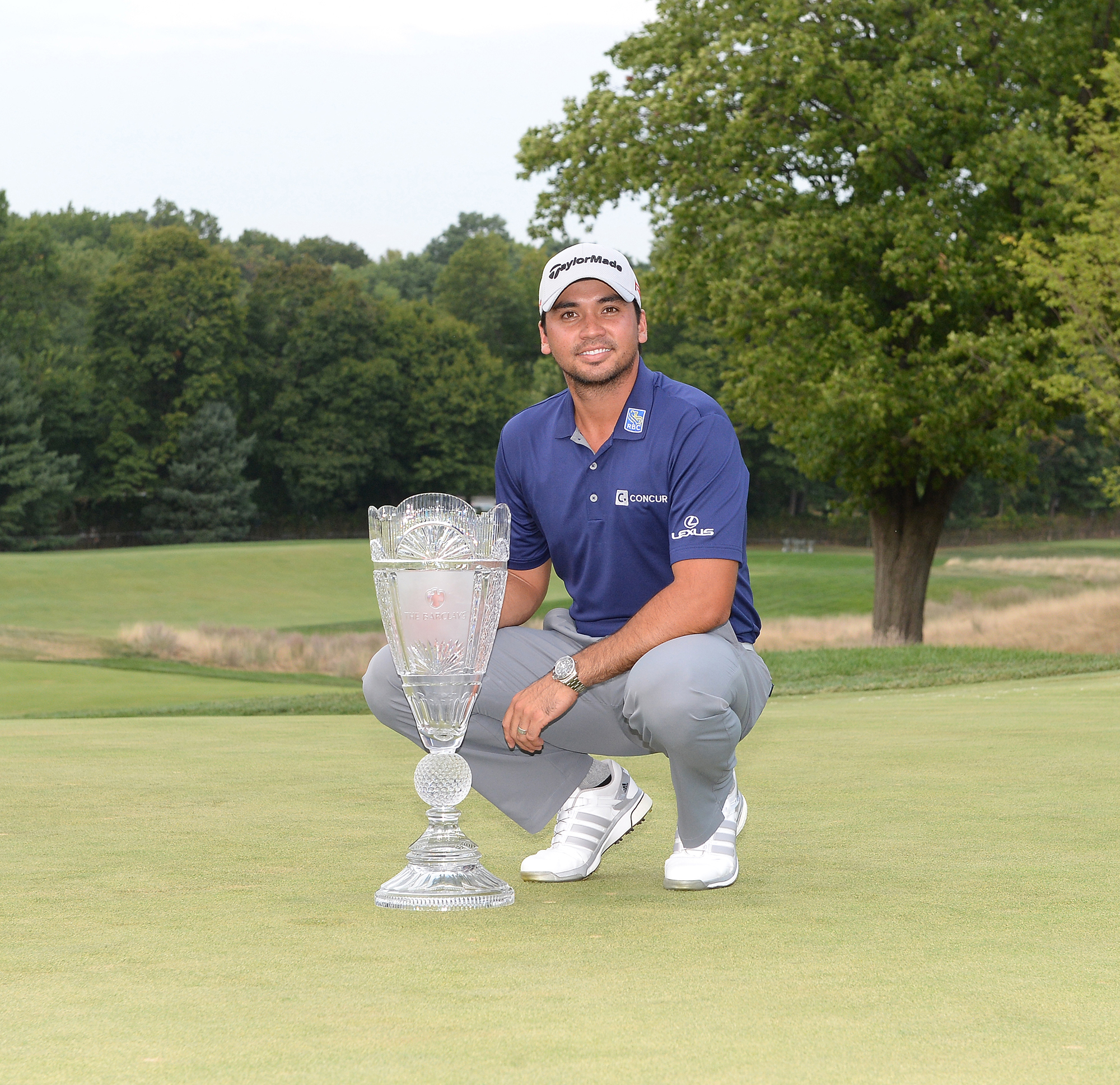

The fairway
is a stretch of closely mowed grass that extends from the tee to the green. The fairway may be a straight path to the green or it may be laid out at an angle, called a dogleg. The fairway is designed to give the golfer the clearest route to the green. Golfers who hit their ball outside the fairway land in the rough. This area borders each side of the fairway. It has higher grass and may include bushes and trees.
The green
is an area at the end of the fairway. The green is covered with special grass that is mowed very closely. It contains a hole 41/4 inches (10.8 centimeters) in diameter and at least 4 inches (10 centimeters) in depth. A movable marker called the flagstick or pin is placed in the hole to show its location.
Play on the hole is completed when the golfer hits the ball into the hole. The number of strokes the player takes to hit the ball into the hole becomes the player’s score for that hole. The player normally takes progressively shorter shots from the tee to the green. Once on the green, the golfer putts (rolls) the ball into the hole with a club called the putter. The surface of the green is usually gently sloped, and the golfer should allow for the slope when putting.
Hazards
are obstacles placed throughout the course to make play more difficult. Golfers try to avoid them. Hazards include bunkers and water hazards. Bunkers are depressions in the ground. If they contain sand, they are called sand traps. Water hazards include ponds and streams. If the ball lands in a water hazard, the golfer may hit it out if the ball is playable. Otherwise, the golfer lifts it out by hand or plays another ball, adding an extra stroke to the score as a penalty.
The equipment
A golfer’s main equipment consists of the ball and a set of clubs. Each club is designed to play a particular type of stroke or to hit the ball a certain distance.
Golf balls
used in competition throughout the world can weigh no more than 1.62 ounces (45.9 grams) and must measure at least 1.68 inches (4.27 centimeters) in diameter.
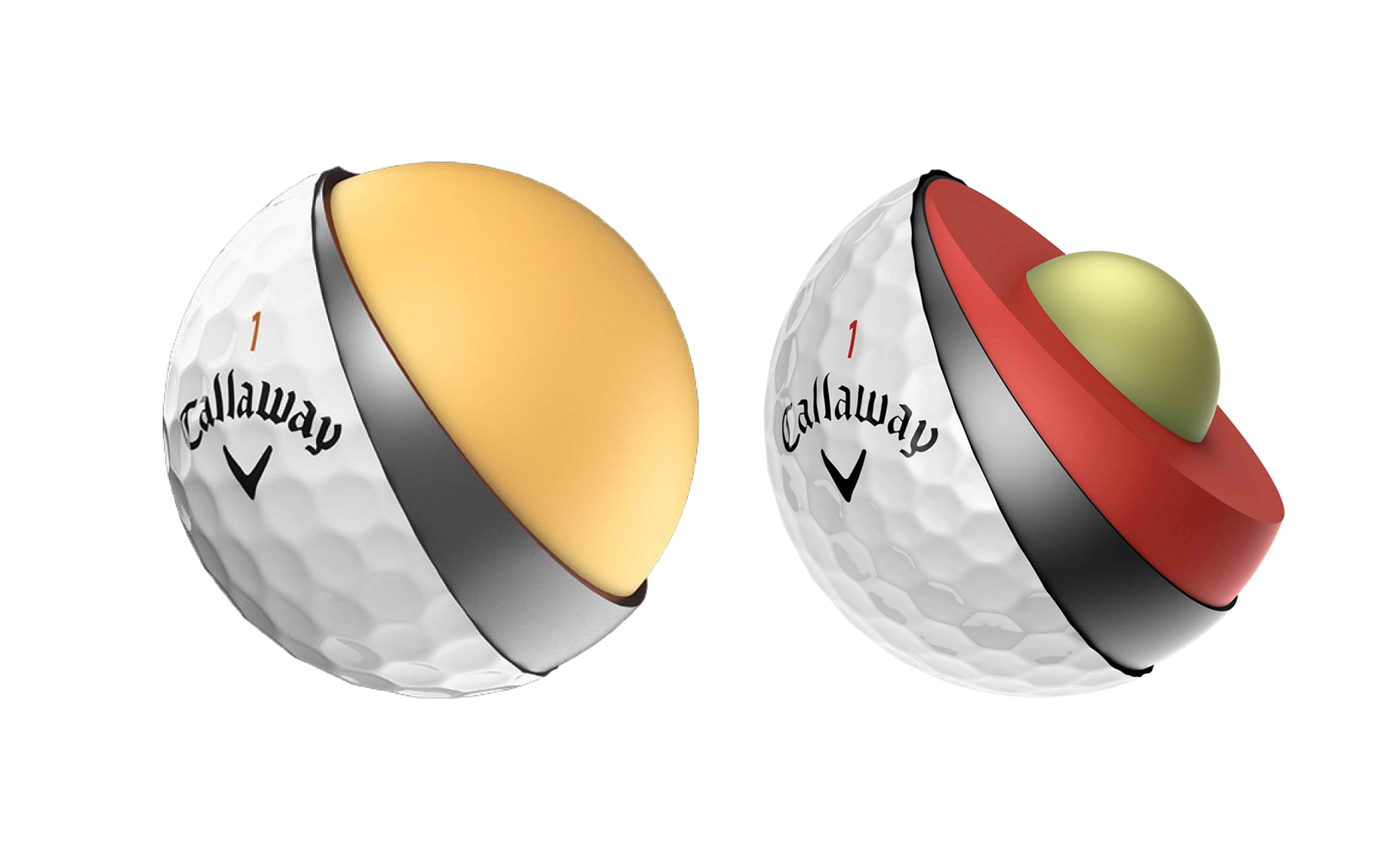
Golf balls usually consist of a solid, round rubber core that is surrounded by one or more layers of other types of rubber or other material. Some balls may contain as many as five layers. The materials used, and the complexity of the manufacturing process, affect their cost, and make them suitable for players of varying skill levels and preferences. Some balls, for example, are designed for greater distance. Others are designed for better control and accuracy around the green. A cover, usually made of urethane or a harder plastic, surrounds the inside layers. The cover may be white or another color, such as yellow or orange. It has many depressions called dimples that increase the ball’s distance and accuracy.
Golf clubs
are slender tubes, usually of steel, with a grip at one end for the golfer to hold and a head at the other for striking the ball. There are two types of clubs: woods and irons. Both underwent major changes during the late 1900’s.
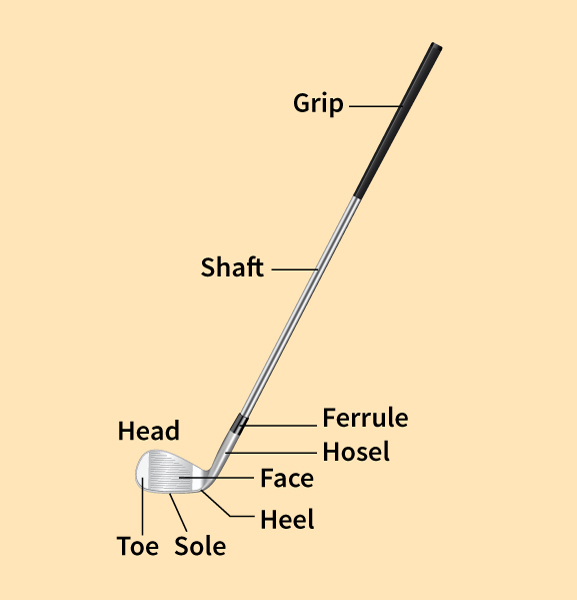
Woods got their name from their large, bulky head made of solid wood. However, beginning in the early 1980’s, most woods had hollow heads made of various metals, such as stainless steel and titanium. Irons have much thinner, bladelike heads. They were first made of iron, then steel, and finally various other metals. Players use woods for the longest shots and irons for shorter shots requiring greater accuracy. Most club shafts are made of steel. Shafts made of graphite or graphite and another material are also popular. In golf’s early days, shafts were made of ash and then hickory.
Woods and irons are usually numbered. The higher the number of the club, the greater is the loft (slope) on the face (front of the head). Each club has a different vertically angled loft. The greater the loft, the higher and shorter the ball will travel. However, clubs with a greater loft are easier for the golfer to control and are more accurate than the lower-lofted clubs. 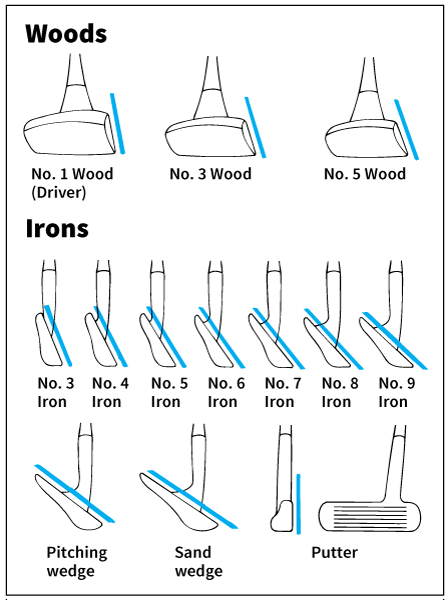

The No. 1 wood, also called the driver, has the least amount of loft of any club except the putter. It also hits the ball the farthest. The driver is used off the tee. Professional golfers and top amateurs will average from about 280 to 300 yards (260 to 270 meters) on a drive. Other woods, called fairway woods, are used for long shots off the fairway. Fairway woods generally include the No. 3, No. 4, No. 5, and No. 7 woods. Professional golfers usually do not carry woods beyond No. 5.

Lofts on irons range from the No. 1, which has the least amount of loft and is rarely used today, to the No. 9, which has the most loft. Other irons include the pitching wedge for short, accurate shots; the sand wedge, for shots from sand traps; and other specialty wedges. Many golfers carry three or four wedges.
In today’s game, many golfers replace the low-lofted clubs with hybrid clubs, which became popular in the late 1990’s and early 2000’s. A hybrid club is a cross between a fairway wood and an iron. Such clubs cause the ball to fly higher and are designed to be easier to swing than long irons. Hybrid lofts generally range from 19 degrees to 30 degrees.
Under the rules of the game, golfers may carry a maximum of 14 clubs during a round. Golfers are free to choose the makeup of their own set. The set used by most professional or top amateur golfers consists of a driver, a No. 3 wood, No. 3 through No. 9 irons, three or four wedges, and a putter. Many players substitute hybrid clubs for the lower-lofted irons.
Golf competition
Golf is played in two basic ways—match and stroke.
Match play.
In match play, one golfer or team plays against one or more others. The player or team hitting the ball into the hole in the fewest number of strokes wins that hole. The player or team winning the most holes wins the match. The score is determined by the number of holes won. A match is decided when a golfer leads by more holes than there are holes left to play. If both golfers or teams make the same score on a hole, that hole is said to be halved. If the two golfers or teams are tied at the end of the match, it is halved and play may continue. Then the player or team who first wins a hole wins the match.
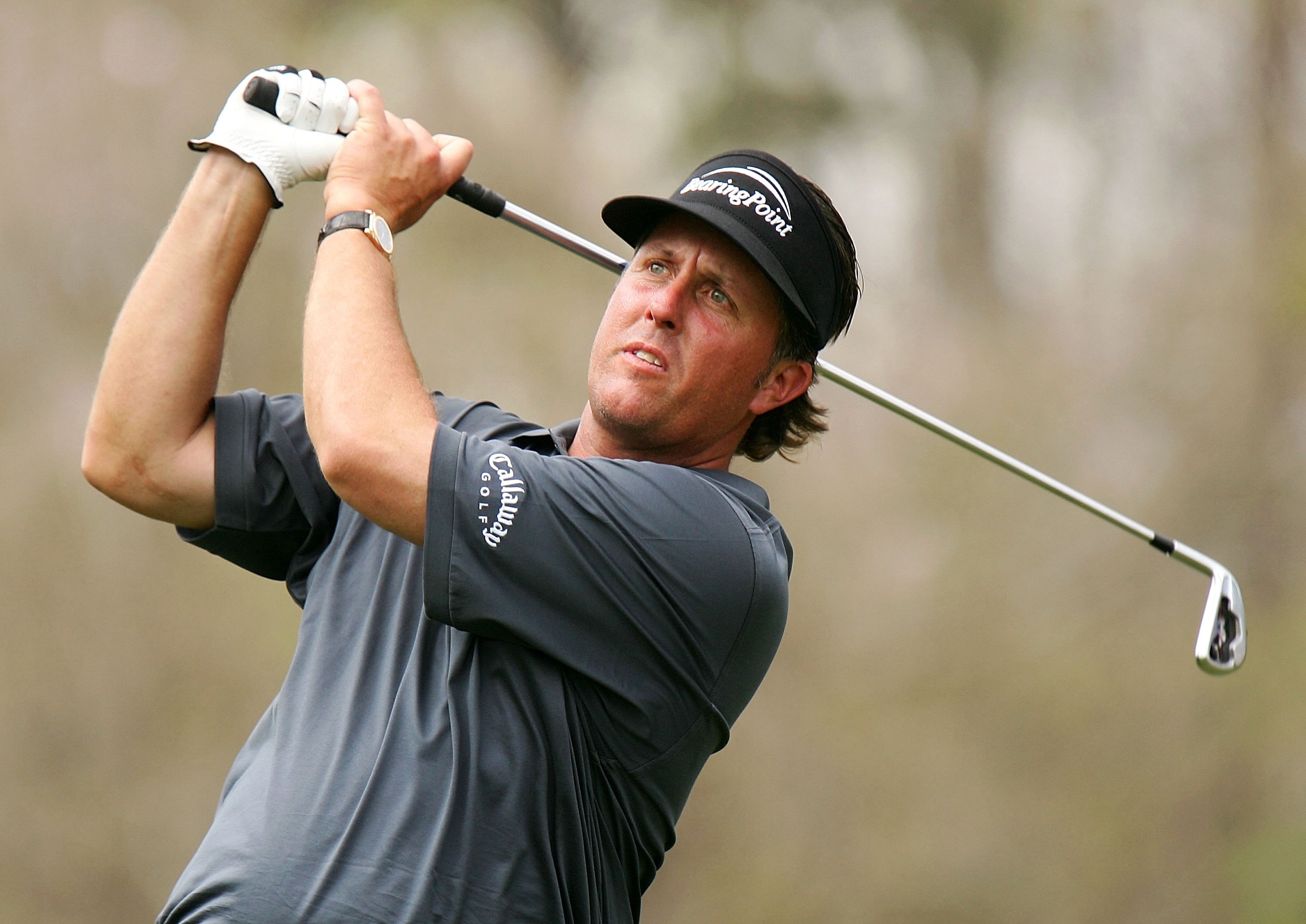
Stroke play.
In stroke play, the winner is the golfer who takes the fewest number of total strokes to complete a competition. Most professional tournaments use stroke play for a total of 72 holes (four rounds). Ties are broken by a playoff. In most playoffs, the tied golfers play until one golfer scores lower on a single hole. In some cases, ties are settled using a three- or four-hole playoff.
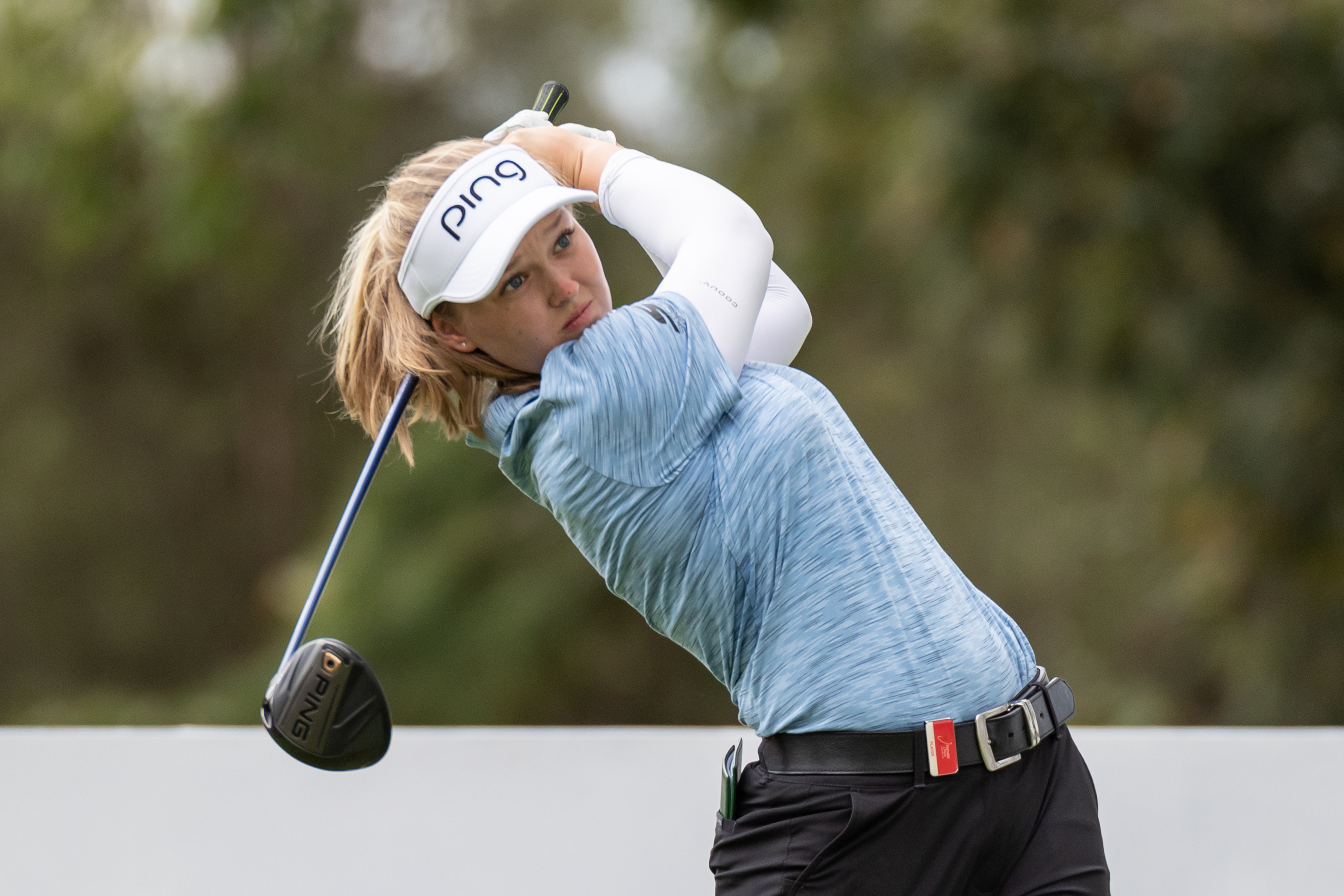
Tournaments.
A group of competitions are known as the “majors” for both men and women. The original four majors for men consisted of the U.S. Amateur, U.S. Open, British Amateur, and British Open. They were won only once in a single year, by the American amateur golfer Bobby Jones in 1930. The major men’s tournaments today, in order of play, are the Masters Tournament, the United States PGA (Professional Golfers’ Association) Championship, the United States Open, and the British Open. Both professional and amateur golfers may enter the two open tournaments or be invited to the Masters. No man has ever won all four tournaments in the same year. However, the American golfer Tiger Woods won the modern four majors consecutively over two years, in 2000 and 2001.
The women’s majors consist of the Chevron Championship (formerly called the ANA Inspiration), the KPMG Women’s PGA Championship (formerly called the Ladies Professional Golf Association [LPGA] Championship), the United States Women’s Open, the Women’s British Open, and the Evian Championship. The Evian became the fifth and final major tournament of the LPGA season in 2013.
The men’s PGA Tour players also compete for the FedEx Cup. Golfers earn points in tournaments played from January through August to qualify for the FedEx Cup Playoffs. The playoffs consist of two tournaments leading to the 30-player Tour Championship tournament. Under a format for the Tour Championship introduced in 2019, players are given stroke advantages based on their accumulated points after the first two playoff tournaments. The player who finishes with the lowest score in the Tour Championship wins the FedEx Cup.
Most countries have amateur competitions for youths and adults. Many countries also compete in international team competitions. In the Walker Cup tournament for amateur men, a U.S. team competes against a team from the United Kingdom and Ireland every two years. The Curtis Cup is a similar tournament for amateur women. In the Ryder Cup, a team of U.S. professional men golfers competes against a team from Europe every two years. In the Presidents Cup, every two years a team of U.S. professional men golfers plays a team from the rest of the world excluding Europe. A team of U.S. professional women golfers plays a team of European women in the Solheim Cup every two years.
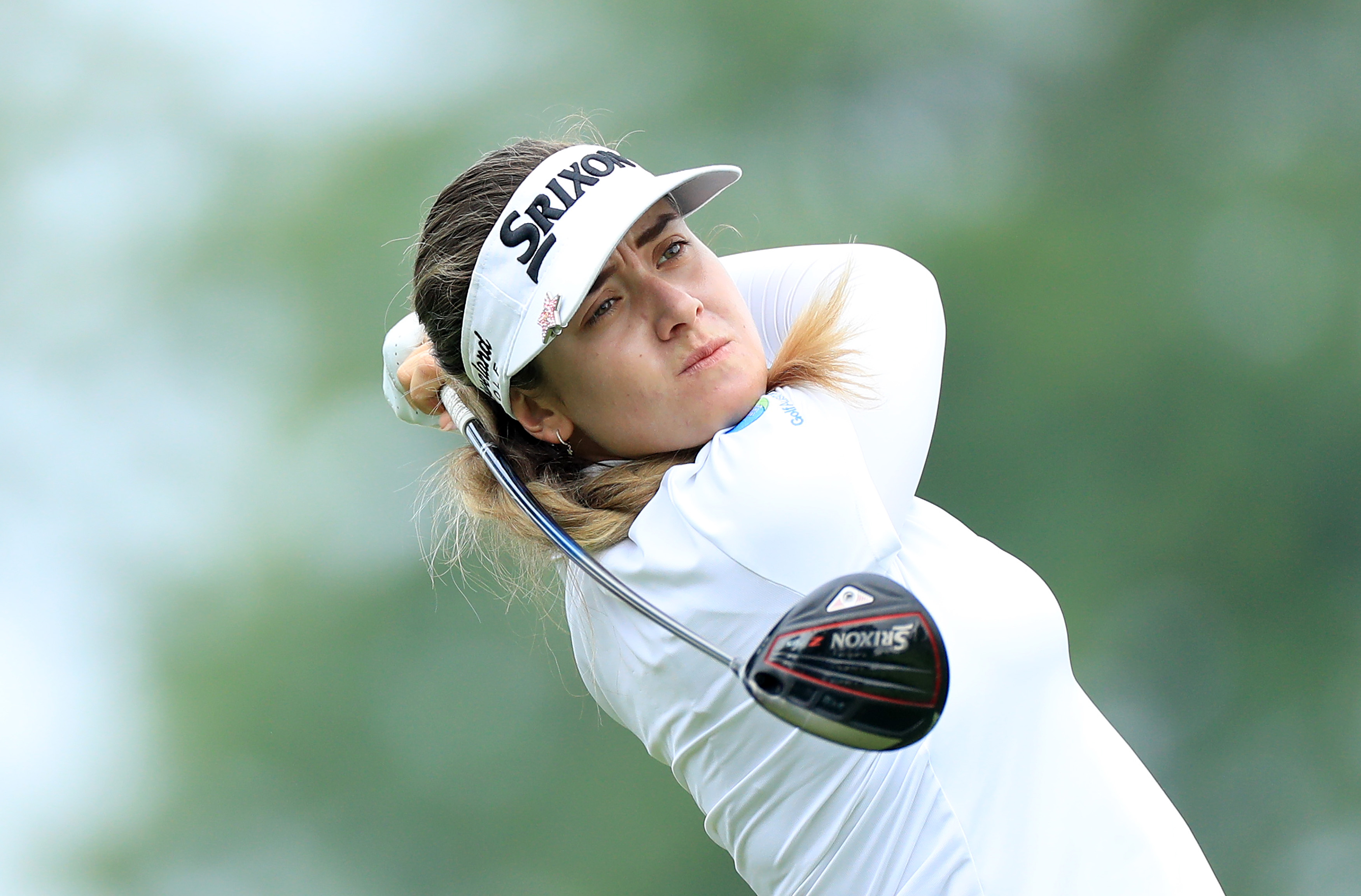
History
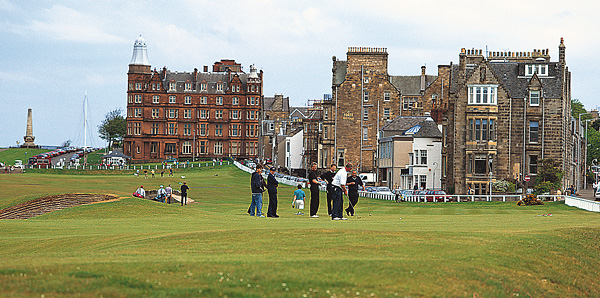
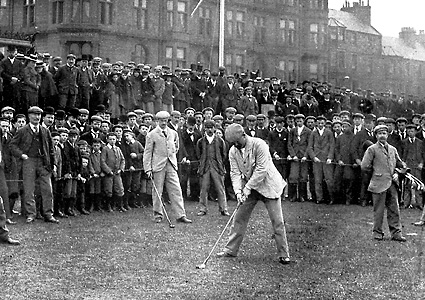


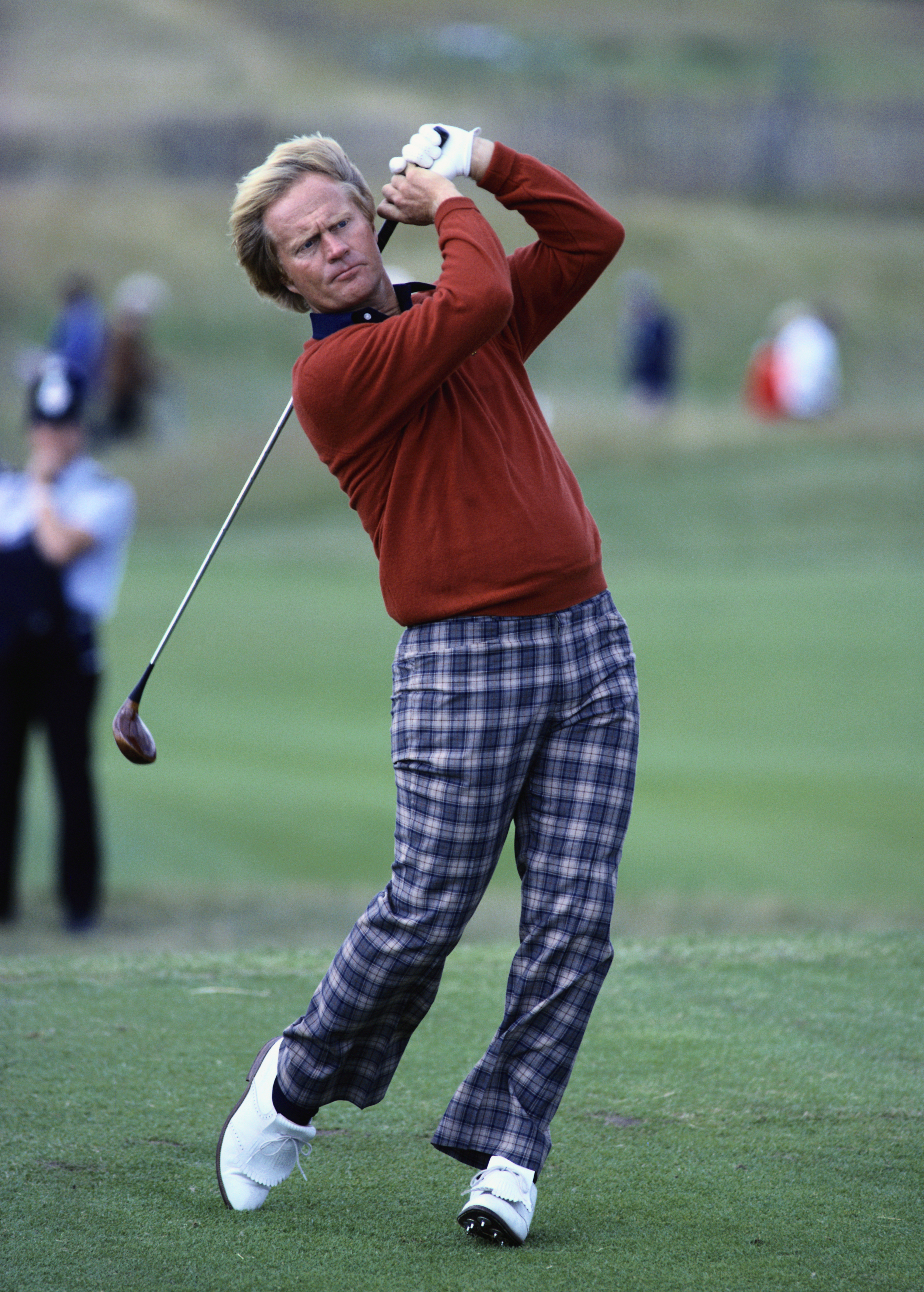
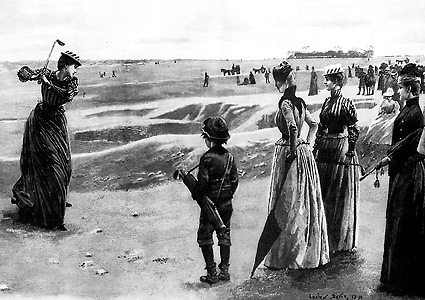



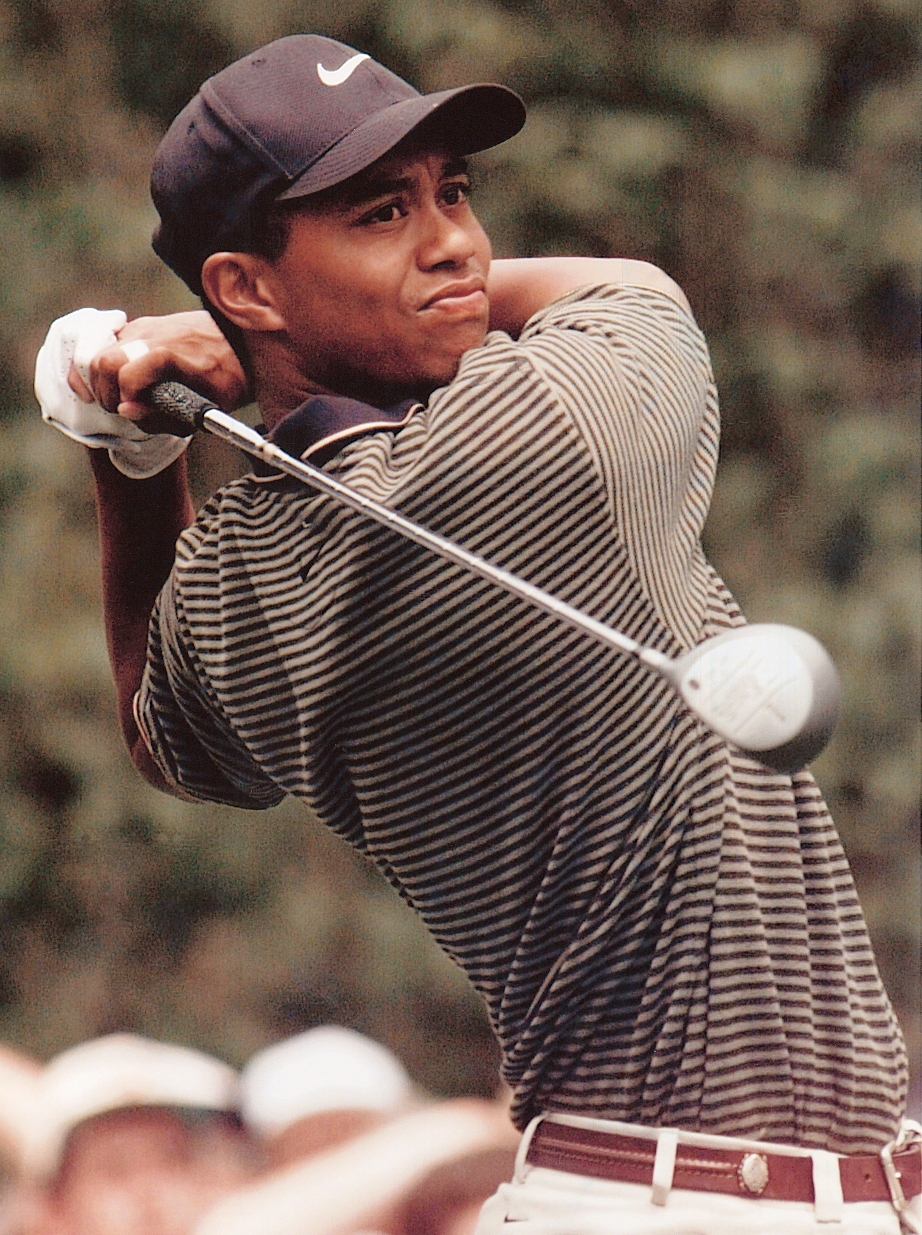
Beginnings.
Some authorities trace golf back to a Roman game called paganica. The Romans, who occupied most of the island of Great Britain from the A.D. 40’s to the early 400’s, played paganica in the streets with a bent stick and a leather ball stuffed with feathers. Other historians trace golf to a Dutch game called het kolven, a French and Belgian game called chole, a French game called jeu de mail, and an English game called cambuca. But most believe golf probably developed into the game as we know it in Scotland.
The Honourable Company of Edinburgh Golfers in Edinburgh, Scotland, is often recognized as the first organized golf club. It was established in 1744 and set down the first written rules of the game. The Royal and Ancient Golf Club of St. Andrews was founded in 1754 as the Society of St. Andrews Golfers. It was the leader in setting golf’s rules and standards. For example, it set the standard round of golf at 18 holes.
Golfers played with a leather-covered ball stuffed with feathers, called the feathery, until the gutty was introduced in 1848. The gutty was a solid ball made of a rubbery substance called gutta-percha. The gutty was later replaced by the rubber-cored ball invented in 1898 by the U.S. golfer Coburn Haskell.
The popularity of golf spread from Scotland and England to parts of the British Commonwealth. The first North American golf club was the Royal Montreal, organized in 1873.
Historians disagree over which existing golf club in the United States was founded first. Among the oldest American clubs are the Dorset Field Club in Dorset, Vermont; the Foxburg Country Club in Foxburg, Pennsylvania; and the St. Andrew’s Golf Club in Hastings-on-Hudson, New York. All three clubs claim founding dates in the 1880’s. The Amateur Golf Association of the United States (now the United States Golf Association) was founded in 1894 to serve as the governing body for golf in the United States. In 1951, the USGA and the United Kingdom’s Royal and Ancient Golf Club of St. Andrews (known as the R&A) agreed to jointly interpret the rules and standards that now govern golf throughout the world.
The rise of professional golf.
In 1916, American professional golfers formed the PGA of America. Until then, amateur golfers dominated the sport. Bobby Jones, who retired in 1930, was the finest amateur golfer of his day. But outstanding professionals, notably Walter Hagen, were beginning to establish golf as a major sport. Hagen was a superb golfer who won additional fame in the 1920’s for his showmanship and flamboyant style. Other leading early professionals included Tommy Armour, Gene Sarazen, Horton Smith, and Joe Turnesa.
Some of the first events on the American professional tour began in the early 1920’s, and the tour became established in the 1930’s. It was led by such golfers as Ben Hogan, Byron Nelson, and Sam Snead. Prize money averaged less than $10,000 per tournament until after World War II ended in 1945. During the late 1940’s, tournament purses in PGA events averaged about $12,000. Hogan and Snead dominated the sport in the 1950’s, along with Jimmy Demaret, Lloyd Mangrum, and Cary Middlecoff. Top professionals of the 1960’s and early 1970’s included the Americans Arnold Palmer, Jack Nicklaus, and Billy Casper, along with Gary Player of South Africa.
The U.S. PGA Tour is the biggest and richest in the world. It oversees more than 40 tournaments, each offering several million dollars in prize money.
Women’s golf
has enjoyed a growth similar to that of men’s golf. From about 1900 through the 1920’s, British amateurs dominated women’s golf. Joyce Wethered was the top British golfer during the 1920’s. By the 1930’s, American women golfers had become important. Top U.S. golfers from the 1930’s through the 1950’s included Patty Berg, Babe Didrikson Zaharias, Betty Jameson, and Mickey Wright.
Widespread interest in women’s professional golf developed after World War II. Berg, Jameson, and Zaharias turned professional and became founders of the LPGA. The LPGA Tour began in 1950 with 11 tournaments. By the early 2000’s, it had about 35 tournaments. Stars of the late 1900’s and early 2000’s included Nancy Lopez, Juli Inkster, and Betsy King of the United States; Laura Davies of the United Kingdom; Annika Sorenstam of Sweden; and Karrie Webb of Australia.
The late 1900’s.
United States golfers dominated golf internationally until the late 1970’s, when golfers from other countries began to emerge. These golfers included Greg Norman of Australia, Severiano (Seve) Ballesteros of Spain, Bernhard Langer of Germany, Isao Aoki of Japan, and Sandy Lyle and Nick Faldo of the United Kingdom. Several professional tours also flourished outside the United States. The most important were the European tour, based in the United Kingdom; the South African tour; the Japanese tour; the Asian tour; and the Australia/New Zealand tour. Among the top U.S. golfers of the 1970’s and 1980’s were Tom Watson, Lee Trevino, Ray Floyd, and Fuzzy Zoeller.
In 1980, the PGA Tour started the Senior PGA Tour (now called the Champions Tour) for players at least 50 years old. Many prominent players from the PGA Tour moved to the Senior Tour, extending their careers as competitive professional golfers. In 1990, a developmental tour, largely for younger players, was established. It is now known as the Korn Ferry Tour. The World Golf Championships began in 1999. The tournaments take place in different countries and feature players from around the world.
Golf today.
Tiger Woods dominated men’s professional golf in the late 1990’s and early 2000’s. In 2000, he won the U.S. Open, the British Open, and the PGA Championship. He won the Masters Tournament in 2001. Woods thus became the first professional golfer to hold all four major titles at the same time. However, health and personal problems plagued Woods beginning about 2008, and he was forced to skip many tournaments. A few notable younger male players emerged, including Rory McIlroy of Northern Ireland; Ricky Fowler, Brooks Koepka, Jordan Spieth, and Bubba Watson of the United States; and Jason Day and Adam Scott of Australia. Woods returned to form and won the Masters Tournament in 2019.
In women’s professional golf, players from South Korea and Taiwan dominated the tour. Inbee Park of South Korea won three women’s majors in 2013. Another South Korean, Se Ri Pak, also won multiple major tournaments, along with Yani Tseng of Taiwan and South Korean-born Lydia Ko of New Zealand. The leading American woman players include Stacy Lewis and Lexi Thompson.
In 2019, rule changes developed by the USGA and R&A took effect. The changes were made to simplify the game and speed up play. The changes include allowing players to leave the flagstick in the hole while putting, and allowing a shorter time for players to search for a lost ball.
In 2022, a new men’s tour, LIV Golf, began play. Unlike most other professional tournaments, which play a total of 72 holes, each LIV Golf tournament consists of only 54 holes. LIV is the Roman numeral for 54. Some top golfers from the PGA Tour began to play on the LIV Golf tour. In 2023, the PGA Tour and the LIV Golf tour agreed to merge.
